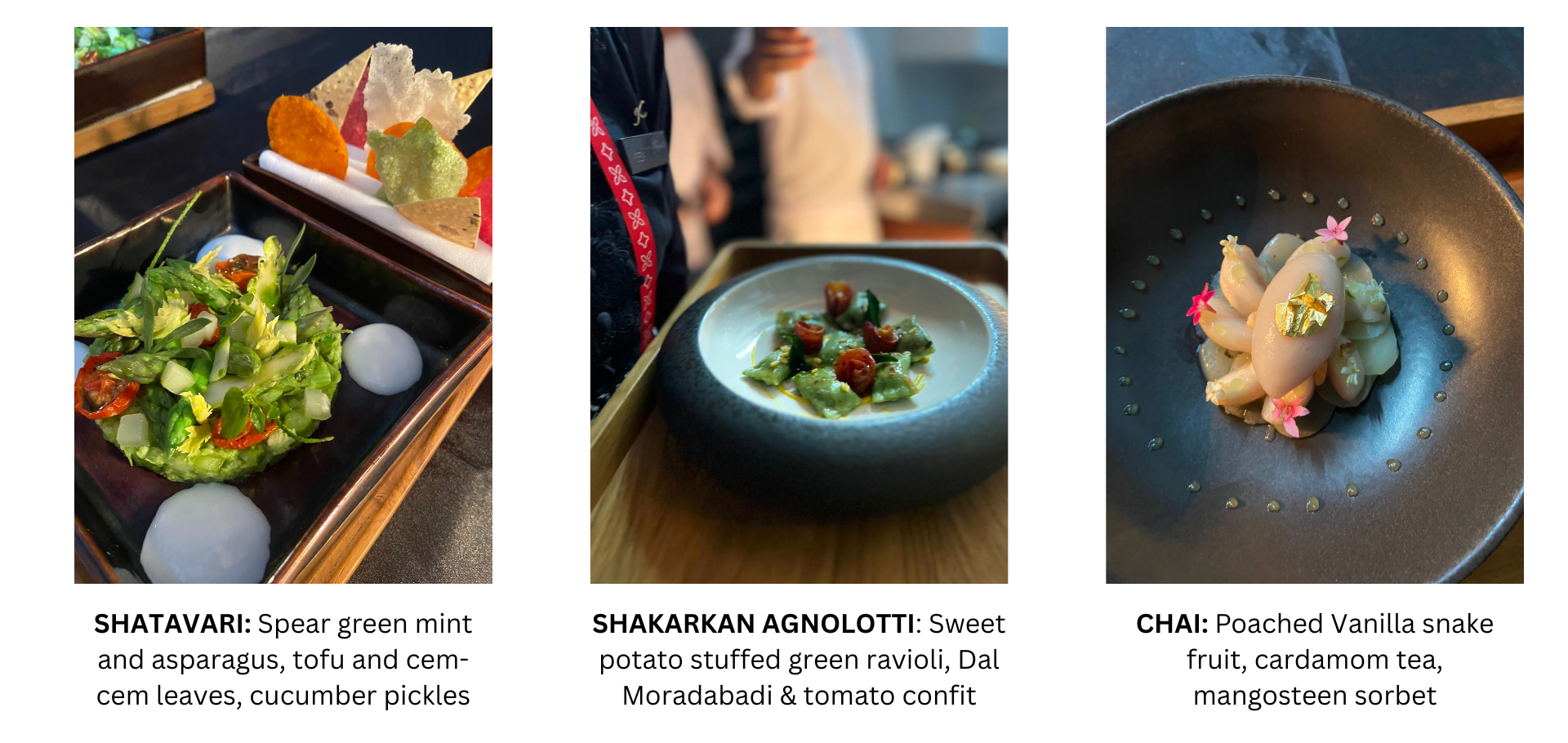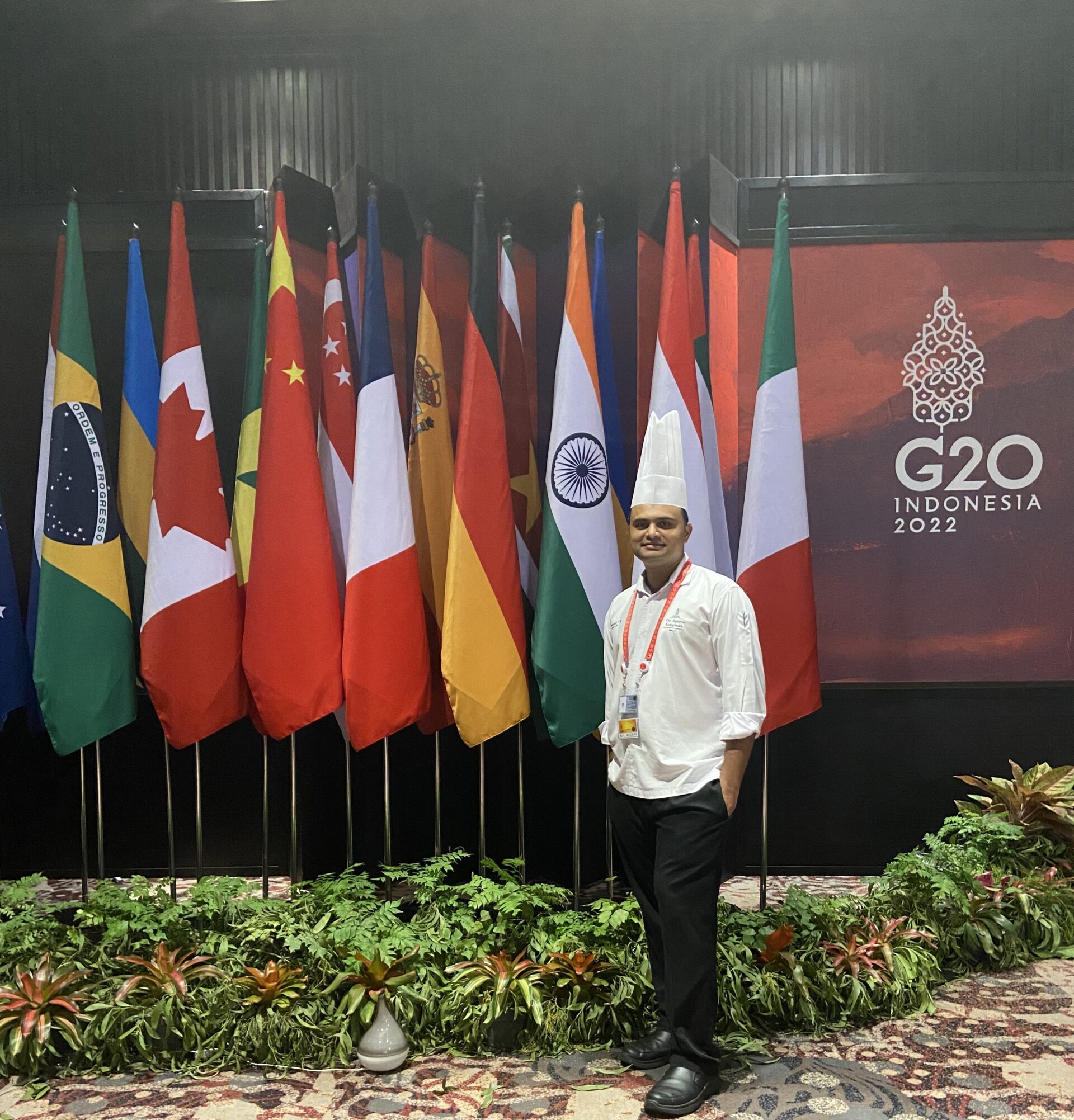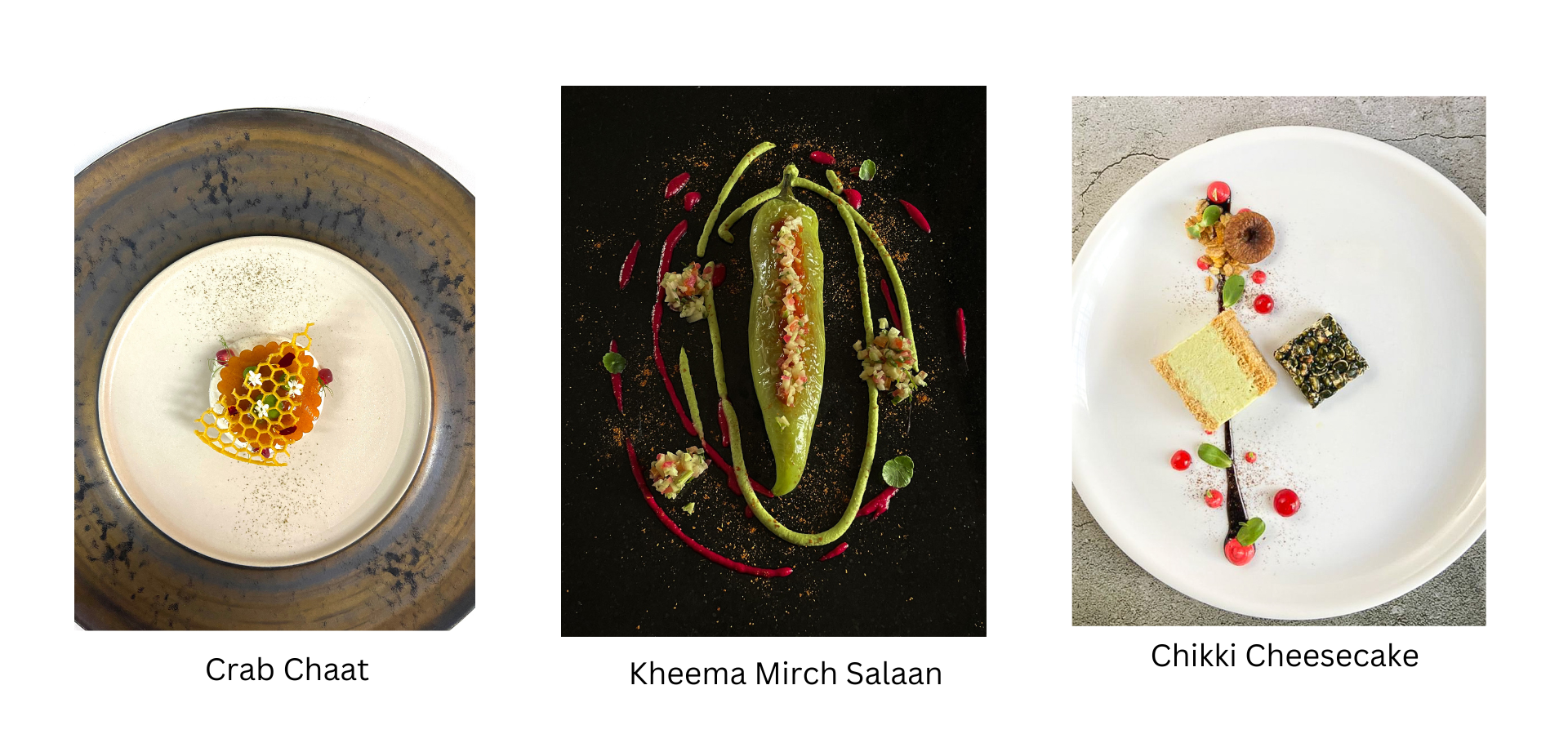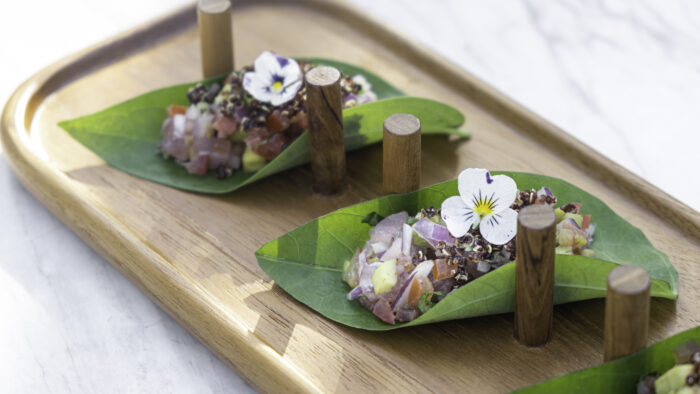The Kempinski is one of the oldest luxury hotel chains serving travellers from across the world for the past 125 years. An immersive and opulent experience is incomplete without the finest flavours local preparations being served on the plate. Making this possible in the culturally rich and historic destination of Bali in Indonesia is a team of chefs and culinary experts.
Bopanna T Nanaiah is the Executive Sous Chef at The Apurva Kempinskii n Nusa Dua, Bali. Hailing from the hilly regions of Coorg in India to making his way to a seaside town in Bali, Bopanna’s love and food explorations cover various facets.
In this conversation, he shares his love for food, the deep connection between Indian and Indonesian cuisines and culture as well as curating a menu for world leaders at the G20 summit held in Bali in 2022.
How did your journey as a Chef begin? What were your motivations?
I would not want to give the standard line of saying I watched my grandmother cooking or helped my mother cook while growing up. I hail from the breathtakingly exotic hilly region of Coorg/Kodagu, which is famous for its prosperous culture, coffee plantations, spices and culinary prowess. I guess being born in a Kodava household, food and cooking exposure was vast within the culture itself. All these factors ignited the flare in me to follow culinary as a profession and I joined the professional culinary arts university in Mangalore, Karnataka. I think this is one of the best decisions I’ve made. Since then, I have had the opportunity to work with some of the world’s top hospitality brands such as Hyatt, Oberoi and Kempinski.
As a chef, I always believed that the true flavours of a region can be found in the food served at hawker streets. So, I have always enjoyed my solo food trips which has tremendously helped me to develop my culinary knowledge and skills. The taste of simple recipes can remind people of their childhood, or multicultural dishes can make others think of their favourite country to visit. I enjoy the sight of my guests being delighted when they taste what I have created.
What is Indonesian cuisine? How is Balinese food distinct?
Indonesia has been my home for a few years now. Indonesian cuisine’s characteristics are heavily influenced by natural and cultural conditions. Basic ingredients consist of a variety of herbs, seasoning, and spices. Indonesian cuisine has never failed to amaze me.
Be it the quirky flavours or some extremely unique ingredients like keluwak (black nut) which is lethal for humans when raw, but given some time and energy which involves boiling and then wrapping them in banana leaves and burying them in ash for a month to release the hydrogen cyanide that makes them poisonous, they become a sought after delicacy in Indonesian cooking.
Similar to this, there are numerous interesting ingredients like tempe (fermented soy bean cakes), kecombrang (torch ginger), Emping melinjo (bitternut cracker) and many more.
Indonesia is a country that celebrates unity in diversity. Even though it has the world’s highest Muslim population, Bali, in contrast, is largely Hindu, with a minority of other religions. As a result, I have observed pork being commonly used in Bali. Balinese cuisine in its own way gets its flavour from some locally sourced staples, namely chili, shallot, garlic, turmeric, wild ginger, torch ginger and other endemic rhizomes. Coconut is also ubiquitous. My favourites being Babi Guling, Balinese suckling pig stuffed with aromatic spices, spit roasted on charcoal to perfection. Bebek Betutu, duck stuffed with spices, wrapped in banana leaves, coconut husks and cooked in pit of embers. These are some local delicacies from Bali.
How did India’s economic and cultural exchanges influence Indonesian or Balinese cuisine? What are some commonalities and differences?
Last year I crafted an Indian-Indonesian menu for one of the restaurants at The Apurva Kempinski Bali. While I was working on this menu, I did my part of research on Indian influences on Indonesia and vice versa. The economic, social and cultural relations between India and Indonesia are very old. According to historical evidence, contact between India and Indonesia was been established when traders from India travelled far and wide in the pursuit of trade. Consequently, there was an all-round cultural exchange that not only affected the economy but also contemporary society and its cuisine. The city of Cuttack in India still celebrates ‘Bali Jatra’ every year, literally 'voyage to Bali', which is organised every year to commemorate the 2,000-year-old maritime and cultural links between ancient Kalinga (today's Odisha) and Bali and other Southeast Asian regions like Java, Sumatra and Borneo.
One of my favourite culinary book K.T Acharya’s ‘A historical dictionary of Indian food’ stated that Idli could have come to India from present-day Indonesia. Similarly, Indonesian dishes like Kari Ayam, Nasi Kebuli, Gulai consist of adaptations of authentic dishes from India.
Indonesia shares a lot of culinary similarities with India. Indian and Indonesian cuisines are popularly known for their sophisticated application of spices in everyday cooking and both nations love eating rice meals and stews. Talking about differences, even though Indonesian cuisine have some good vegetable dishes, Indonesians in general are not fond of a vegan and vegetarian diet. In this aspect, Indian cuisine tops the charts.
As a travel destination, many people come to Bali to escape the hustle and bustle of their daily lives and finally find peace between the nature and culture of Bali. A large part of tourist flock to explore the serene and yogic way of living which Bali has accepted from India centuries ago. But the beauty of Bali is that it has welcomed and adapted the science of yoga, healing and Ayurveda in its own way.
Talking about culinary practices, India is renowned for the simplistic cooking techniques which maintain the food’s nutritional value as well as enhance the taste by using various spices and mixes. I have observed similar style of cooking styles, usage of ingredients and eating habits in Indonesia as well.
What are some of the efforts taken by governments, policy-makers and private players to spread and promote Indonesian cuisine to the world?
The role of food or culinary tourism has become increasingly important for gastrodiplomacy. There are a lot of local food that potentially offer a strong focal point to portray Indonesia as a tourism destination. In the past few years, the government has taken some impressive initiatives to promote Indonesian traditional culinary and re-appreciate the traditional food of the country.
To do so, relevant stakeholders such as industry associations, tourism business owners, and educational institutions have been invited to step in to actualise and promote Indonesian cuisine both to domestic and international markets.
In Bali itself, Indonesian cuisine has regained its popularity where the traditional food is not just sold at local food street hawkers but there are growing numbers of medium to large scale restaurants that specialise in traditional Indonesian food with modern techniques and plating.
How did G20 serve as a chance to promote Indonesia’s gastrodiplomacy? What were some of the native authentic dishes prepared and served by you?
Handling the G20 summit was once in a life time unparalleled experience. You are always nervous considering the fact that you are serving the most prominent world leaders under one roof.
Along with serving flavourful local cuisine, it was a mammoth task to ensure safety, customise every dish based on leaders’ dietary preferences and restrictions. The menu designed for G20 Indonesia was inspired by various ethnic groups of Indonesia.
The dishes were crafted by the team of The Apurva Kempinski Bali along with the guidance of Indonesian culinary ambassador, William Wongso.
It took around 8 months of constant trials to get to what we wanted to portray to the world. We wanted to make sure the plate served to dignitaries tells the story about Indonesia. The menu for 40 heads of states and chiefs of global organisations had traditional delicacies such as Selada Udang Bangka (shrimp turnip salad), Cumi bumbu rujak (Baby squid with spiced coconut cream), Sate pusut ikan Mandalika (Fish satay), Panggang Ikan bumbu Bali (Balinese grilled fish), Nasi Ungu urap sayur (Heritage purple rice), Emping jogja (Yogyakarta melinjo chips), Nangka Kelapa Muda (Jackfruit, palm sugar and young coconut pudding). Though every dish tasted very authentic, yet it was very progressive in its presentation.

Menu served during a working bilateral lunch meeting between Indian PM Narendra Modi and French President Emmanuel Macron.
Though the G20 in Indonesia culminated last year, how did it create a lasting impact to boost Indonesia and particularly Bali’s tourism and cultural economy?
The eyes of the world turned to Bali in November 2022, as global leaders arrived for the G20 Summit. Holding the G20 Summit in Bali delivered a strong propulsion to the recovery of Indonesia’s tourism sector post the dreadful Covid 19. The summit’s successful execution also demonstrated the country’s capacity to welcome international visitors at the very highest level. That provides evidence that Bali is a very safe and a comfortable place for tourists to travel. And, that has made a lot of tourists want to visit Bali for vacation. I strongly believe that G20 Summit contributed to Bali’s economic growth and provided a multiplier effect on the tourism industry at all levels.

Despite having a centuries-old civilizational connection, Bali today has more Chinese and Italian eateries than Indian. How can Indian cuisine be popularized in Indonesia?
I reckon in some parts of the world the most common misconception is to approach Indian cuisine with the assumption that it is very spicy and not suitable for everyone’s palate. Indian food is a festival of flavours and can weave magic for your taste buds. Some Indian eateries in Bali have tried to modify the Indian food to the local palate and have ended up losing the soul.
In 2022, I launched an Indian- Indonesian themed menu in one of the restaurants at Kempinksi Bali. I clearly understood that the flavours of Indonesian and Indian cuisine complement each other really well and the concept at this restaurant was an instant crowd-puller. Menu comprises of authentic Indian dishes, traditional Indonesian dishes and some inventive Indo-Indian dishes such as Rendang samosa, Tandoori ayam taliwang, Jimbaran fish tikka, Pelalah naan and more.

Indian-Indonesian fusion preparations
Being an Indian chef, I have always believed that it is my responsibility to propagate Indian cuisine to the world and I try to do it regularly with all the love and passion which I have for food. With the soaring growth of Indian tourists to Bali, I am certain that Indian cuisine will exponentially grow in Bali in years to come.





